Natural Area Preservation News
Protecting and restoring Ann Arbor's natural areas and fostering an environmental ethic among its citizens.
Volume 19, Number 2
Summer 2014
Molly Notarianni
I began my investigation of Sunset Brooks with a personal visit to the park. As I hiked through the deep snow of late February, the first thing I noticed was the park’s gentle topography. Oaks and hickories dotted the woods, and a homemade bridge spanned a small stream. I also noticed several strategically placed benches, one at the top of a hill, another under the spreading canopy of a tall pine. I was struck by these thoughtful gestures: this was clearly a site that was well-loved, and well-used, by its neighbors.
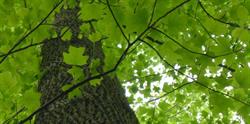
The entrance to Sunset Brooks Nature Area is nestled between houses on a quiet street in the Water Hill neighborhood: the gateway to 7.8 acres of rolling woods and wetland hugged on the north by M-14. Located just south of larger natural areas such as Bird Hills and Kuebler Langford, Sunset Brooks can be easy to overlook. While it may be small in size, Sunset Brooks definitely deserves a second look. This tiny park is a gem, with an amazing history of involvement by dedicated neighbors.
Park Steward Jim Crosby has lived adjacent to Sunset Brooks for more than thirty years, and has been a Park Steward working with NAP for nearly 10 years We met one chilly March morning to talk about the park. Jim handed me a sheet he created entitled “Sunset Brooks features,” which listed many of the elements I had already noticed, as well as some I’d missed, like a grove of dogwoods whose beautiful flowers Jim enjoys each spring. He explained how he had worked hard to make sure park users of all ages and abilities could enjoy the woods. The trails are kept wide and leveled, and those benches I’d noticed were installed so park users could take a rest at the most scenic spots.
In the course of our conversation, we finally made it to the exciting part: the neighborhood saved the park from development! As the story goes, the site was bought and sold in quick succession by several developers, and was ultimately slated to be developed into 33 condominiums. Jim and the other park neighbors didn’t want to see the neighborhood woods demolished, and attended many Planning Commission and City Council meetings to voice their concerns. Eventually, they decided to take matters into their own hands, advocating for the City of Ann Arbor to purchase the site for parkland.
David Leroy, another neighbor, organized the Greater Sunset Brooks Neighborhood Association. The group committed to raise the funds for 25% of the purchase price of the site. In a partnership with the Ann Arbor Community Foundation, the group developed a fund for community donations. Within a year’s time, 96 neighbors contributed to the project, raising more than $93,000. After this demonstration of support from the community, and with this financial assistance, the City decided to purchase Sunset Brooks Natural Area.
Twenty years later, people continue to be inspired to care for this small neighborhood park. In 2013, longtime NAP volunteer, Brooks Curtis, decided to become a Park Steward and Sunset Brooks stood out to him as the obvious choice. Brooks has been hard at work through the fall and winter months, removing invasive buckthorn and honeysuckle.
The final item on Jim’s list of Sunset Brooks features is “nice neighbors.” This struck me as a perfect summary. While this natural area may not be home to endangered wildflowers or rare salamanders, it is well-used, and well-loved by its neighbors. Through their hard work and dedication, Sunset Brooks was preserved, and remains to this day a beautiful spot for all to enjoy.
You can enjoy Sunset Brooks Nature Area while lending a hand with the restoration efforts there at a Stewardship Workday on Saturday, June 22. See page 4 for more information.
David Borneman, Deputy Manager for Volunteerism and Natural Area Preservation
A few years ago, NAP got a button-maker. Perhaps you’re even the proud owner of one of our buttons. We have a wide variety of styles, and have some custom-made for different types of volunteers. Staff had fun creating all of these designs, one of my favorite being a button that says simply, “I am NAP.”
It’s been a year of tremendous staff turnover at NAP. Three staff with 30 years of collective experience with the City moved on to other opportunities. Another handful of shorter-tenured staff also left. At a recent all-staff training, during introductions, some newer staff were surprised to realize that they were, in fact, the veteran staff present, despite being with NAP for less than a year themselves!
How does an organization like NAP get through such major change, where a large percentage of our staff wasn’t even here a year or two ago? Sure, this happens at many park facilities, but the special challenge for NAP is that our work is spread out across 1300 acres in 100 or so city parks. Well, fortunately, NAP is not just about the staff. It’s about ALL of us, all of YOU. The hundreds of long-time, returning volunteers helping to restore our natural areas have provided an unbroken backbone of continuity through the years in many of our parks. For some Park Stewards, their connection to that natural area started long before NAP came into being.
More and more, the role of NAP staff is to help facilitate the stewardship work of volunteers in the parks. We provide some expertise in the field of ecological restoration, and apply that knowledge to help set restoration goals for sites. And we maintain records that track work done over the years by a variety of staff and volunteers. We also provide and maintain the equipment needed to do that work. But a large part of the staff’s efforts is to facilitate volunteers doing much of the restoration work that is needed.
So, yes, the tremendous staff turnover does create some challenges for us. And yes, there will be things that slip through the cracks. We ask for your patience during this time of transition. But fortunately, and very thankfully, much of the detailed on-the-ground knowledge about the restoration work that has been done, and still needs to be done at individual parks remains intact in the minds of the hundreds of volunteers who have done this work in the past, and will continue - in partnership with NAP staff – to do this work well into the future.
If you’re not currently one of these “knowledge keepers” – if you aren’t currently a Park Steward of your favorite natural area – I invite you to step up and volunteer to accept this responsibility. After all, YOU are NAP. Each of you working out there pulling garlic mustard, or cutting buckthorn, or maintaining trails or volunteering in dozens of other ways can proudly proclaim, “I am NAP!” We’ll even give you a button that proclaims that to the world!
NAP loves gardening! It’s a great way to provide a little extra support and habitat for the insects, birds, and other pollinators so essential to the ecosystem. Be careful about the plants you chose, as many of the readily-available, “easy care” plants offered at garden centers are not native to Michigan, and some can escape from your landscaping and become invasive in our natural areas. Below are some invasive plants that are commonly used in landscaping and some native alternatives.
Vinca, Myrtle, or Periwinkle (Vinca minor) This thick groundcover, pictured above at left, is attractive for its evergreen leaves, small violet flowers, and its ability to grow in a variety of light conditions. In a natural area, however, it forms thick mats and crowds out native vegetation. Instead, try planting wild strawberry (Fragaria virginiana), creeping strawberry-bush (Euonymus obovata) pictured above at right, or partridge-berry (Mitchella repens).
Japanese Barberry (Berberis thunbergii) This low-growing shrub, pictured above at left, is very common in landscaping. Known for its densely flowering stems, red fall foliage, and red winter berries, this shrub displaces native plants, alters soil chemistry, and its prickly stems make poor habitat for wildlife. As an alternative, try planting Michigan holly (Ilex verticiallata), ninebark (Physocarpus opulifolius) pictured above at right, or prickly gooseberry (Ribes cynosbati).
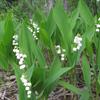
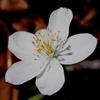
Lily-of-the-Valley (Convallaria majalis) Lily-of-the-valley, pictured above at left, is widely planted as a ground cover, especially in shady areas. Its delicate, fragrant flowers are pleasant in the spring, and its leaves can stay green throughout the winter. But in natural areas, the plant takes over native habitat, and every part of it is highly poisonous. Wild ginger (Asarum canadense), false rue anemone (Enemion biternatum) pictured above at right, and zigzag goldenrod (Solidago flexicaulis) are possible native substitutes.
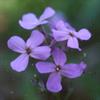
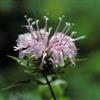
Dame’s Rocket (Hesperis matronalis) This fragrant garden plant, pictured above at left, with showy pink, white, or purple flowers is easily confused with native phlox. When attempting ID, know that dame’s rocket’s flowers have four petals instead of five. This woodland invader is almost as aggressive as garlic mustard, and it quickly uses up resources needed by native plants. Wild blue phlox (Phlox divaricata), wild bergamont (Monarda fistulosa) pictured above at right, and wild columbine (Aquilegia canadensis) make good alternatives.
-
Bill Kidd - Furstenberg Nature Area
-
Emerson School - Barton Nature Area
Many thanks to the groups who volunteered with NAP recently. We could not make such a difference without you!
-
Envirodems
-
EMU VISION
-
Organizing for Action
-
Skyline High School Interact
-
Temple Beth Emeth
-
UM Alpha Epsilon Delta Pre-Health Honor Society
-
UM Circle K
-
UM ECON 108
-
UM Theta Xi
University of Michigan SNRE student Ari Kahan studied Black Pond Woods as part of his Master’s thesis, which looked at whether increased urbanization affects soil chemistry in protected forest areas. Soil chemistry is important because it affects the plants and animals that may be found in protected areas, as well as the management strategies that may be used in those areas. Kahan found that there is an increase in the amount of nitrogen in forest soil as housing density in the surrounding landscape increases. This increase in nitrogen is also related to increased overstory biomass.

Robby Johnston, Field Crew
I've worked at NAP as long as I've lived in Ann Arbor; so, it's impossible for me to separate living in this city from the experience of working to restore its natural treasures. I'm committed to continued work in stewardship, education, and conservation, as well as working as an artist, author, and illustrator. [You can keep up with Robb at robbnjohnston.com!]
Rachel Maranto, Field Crew
After two years on the field crew, I have taken a job with Michigan Nature Association as their Regional Stewardship Organizer for the southeast lower peninsula. I made many lasting friendships at NAP. I will miss Ann Arbor's nature areas, although I look forward to enjoying them without having to think about work!

Kegan Schildberg, Field Crew
Over the past year I've learned and grown a lot, and worked with some really awesome people. I'm reluctant to go, but I'm excited to take on new challenges with Oakland County. I'm going to miss the crew and the awesome volunteers.

Molly Notarianni, Park Steward Coordinator
After the past ten years working in sustainable agriculture, I enjoyed the opportunity to get back to my “roots” in ecology and botany. Unfortunately, my time at NAP is nearing its end: In April I set out for Portland, OR to start a new job managing several large farmers markets. I’ll miss all of you!
Staff Updates: Welcome...

Cristine Santanna, Field Crew
I have a B.S. in the Program in the Environment from the University of Michigan, where I specialized in terrestrial ecosystems and did research on Michigan's vines and lianas. After working for Matthaei Botanical Gardens & Nichols Arboretum in Ann Arbor, and for The Nature Conservancy in Swanton, OH, I was certain I wanted to pursue a career in ecological restoration and conservation. I am very excited for being part of NAP's field crew this year and help to restore our beautiful nature areas to health!

Nate Helms, Field Crew
I am a graduate of Humboldt State University, with a B.S. in Wildlife Management and Conservation. I have worked in the fields of endangered species management, and as a research technician for the last five years in California. I am excited for this new opportunity at NAP, conducting ecological restoration within Ann Arbor’s beautiful natural areas. Furthermore, I look forward to working with the community, and helping to facilitate a learning experience for all of our dedicated volunteers.

NAP and Parks and Recreation are excited to welcome Erika Pratt as the new Volunteer and Outreach Coordinator for the GIVE 365 Program. GIVE 365 is NAP’s sibling volunteer program under Parks and Recreation, providing exceptional experiences for volunteers working at Parks and Recreation facilities and venues.
Erika has an MS degree in Parks, Recreation and Tourism Resource/Urban Affairs from MSU, and has been a member of MRPA (Michigan Recreation and Parks Association) since 2000. Her recent work experience includes time with the Novi Parks Foundation and the Pleasant Ridge Recreation Department.
NAP is looking forward to working with Erika and the GIVE 365 team to help improve and maintain all of Ann Arbor’s parks and park facilities!
You can find Erika and GIVE 365 at NAP’s new office location: 3875 E. Huron River Drive.
